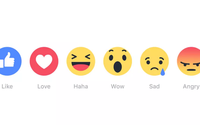Commentary
Facebook Reactions: Your Newsfeed Is About To Get A Little Emotional
- by Melanie Nayer , Op-Ed Contributor, February 24, 2016
Facebook unveiled a major change in how users feel today. After months of speculation and testing, the social network finally rolled out reactions for users beyond a simple “like.” Facebook users will start to see these new reaction icons in their feed over the next few days.
The update features five new reactions – Love, Haha, Wow, Sad and Angry – in addition to the traditional “Like” button.
What Are Reactions?
Reactions work in the same way as likes: You simply hold down the “Like” button (on mobile) or hover over it (on desktop) to view all five reactions, then tap the reaction you want to add to a post. Just as you can with likes, users can see how many people react to a post, only this time, you’ll get a more varied sense of their reaction.

This change has been in the works with Facebook for a while now. Facebook users have
been clamoring for a “dislike” button for some time, but Facebook wasn’t satisfied with the idea of a like or dislike approach. Instead, the social network worked to find universal
sentiments that users around the world could relate to when engaging with a post.
advertisement
advertisement
With the addition of Reactions, the way a post is viewed will be slightly different. Within the feed, the three most used reactions to that post will appear. Comments are now collapsed by default, but by scrolling over the icons you’re able to see the breakdown of reactions from every user.

The Reactions work across organic and paid posts and Facebook Insights has confirmed that Reactions will be added to their Insight reports.
What This Means For Brands
Brands can now better understand sentiment in real time, giving them a post-level gauge to better inform them how consumers are reacting to what they’re posting on their page.
Often times, a "like" was really a "love," or silence was really a sign of dislike. This new level of insight can act as an early warning system, letting brands know that it's time to pull the plug. It can also act as preliminary insight for the type of content that is doing well and resonating with fans.
Reactions won’t, however, change customer service conversations between brands and consumers, which are very common on Facebook posts. Additionally, since “comments” are now collapsed by default, the posts themselves will be the forefront of the page, and users will need to click on comments to see what other people wrote.
Reactions are used on all posts, so whether it’s a photo, link, video or copy, brands will be able to get a better sense of how their fans are feeling about their posts and products.
What’s To Come
As for next steps and future rollout of more reactions, we’ll have to wait and see what Facebook brings forth. For now, according to reports, “Love” is the most consistently used reaction around the world, and now on Facebook.


